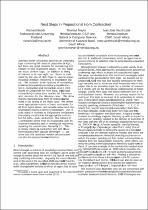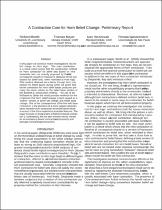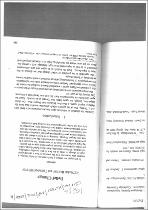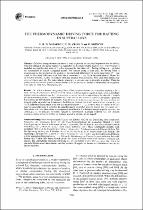JavaScript is disabled for your browser. Some features of this site may not work without it.
- ResearchSpace
- →
- Research Publications/Outputs
- →
- Conference Publications
- →
- View Item
| dc.contributor.author |
Booth, R

|
|
| dc.contributor.author |
Meyer, T

|
|
| dc.contributor.author |
Varzinczak, IJ

|
|
| dc.date.accessioned | 2009-09-17T08:32:55Z | |
| dc.date.available | 2009-09-17T08:32:55Z | |
| dc.date.issued | 2009-06 | |
| dc.identifier.citation | Booth, R, Meyer, T and Varzinczak, IJ. 2009. Next steps in propositional horn contraction. 9th International Symposium on Logical Formalization of Commonsense Reasoning: Commonsense 2009, Toronto, Canada, 1-3 June, 2009. pp 1-6 | en |
| dc.identifier.isbn | 978-0-9802840-6-5 | |
| dc.identifier.uri | http://hdl.handle.net/10204/3597 | |
| dc.description | 9th International Symposium on Logical Formalization of Commonsense Reasoning: Commonsense 2009, Toronto, Canada, 1-3 June 2009. This paper was also delivered at the 21st International Joint Conference on Artificial Intelligence (IJCAI-09), Pasadena, California, USA, 11-17 July 2009 | en |
| dc.description.abstract | Standard belief contraction assumes an underlying logic containing full classical propositional logic, but there are good reasons for considering contraction in less expressive logics. In this paper, researchers focus on Horn logic. In addition to being of interest in its own right, the choice is motivated by the use of Horn logic in several areas, including ontology reasoning in description logics. Three versions of contraction were considered: entailment-based and inconsistency-based contraction (e-contraction and i-contraction, resp.), introduced by Delgrande for Horn logic, and package contraction (pcontraction), studied by Fuhrmann and Hansson for the classical case. Researchers showed that the standard basic form of contraction, partial meet, is too strong in the Horn case. Researchers define more appropriate notions of basic contraction for all three types above, and provide associated representation results in terms of postulates. Results stand in contrast to Delgrande’s conjectures that orderly maxichoice is the appropriate contraction for both and i-contraction. The interest in p-contraction stems from its relationship with an important reasoning task in ontological reasoning: repairing the subsumption hierarchy in EL. This is closely related to p-contraction with sets of basic Horn clauses (Horn clauses of the form p → q). It was shown that this restricted version of p-contraction can also be represented as i-contraction. | en |
| dc.language.iso | en | en |
| dc.subject | Horn contraction | en |
| dc.subject | Belief change | en |
| dc.subject | Horn logic | en |
| dc.subject | Ontology reasoning | en |
| dc.subject | Contraction | en |
| dc.subject | Commonsense reasoning | en |
| dc.subject | Entailment-based contraction | en |
| dc.subject | Inconsistency-based contraction | en |
| dc.title | Next steps in propositional horn contraction | en |
| dc.type | Conference Presentation | en |
| dc.identifier.apacitation | Booth, R., Meyer, T., & Varzinczak, I. (2009). Next steps in propositional horn contraction. http://hdl.handle.net/10204/3597 | en_ZA |
| dc.identifier.chicagocitation | Booth, R, T Meyer, and IJ Varzinczak. "Next steps in propositional horn contraction." (2009): http://hdl.handle.net/10204/3597 | en_ZA |
| dc.identifier.vancouvercitation | Booth R, Meyer T, Varzinczak I, Next steps in propositional horn contraction; 2009. http://hdl.handle.net/10204/3597 . | en_ZA |
| dc.identifier.ris | TY - Conference Presentation AU - Booth, R AU - Meyer, T AU - Varzinczak, IJ AB - Standard belief contraction assumes an underlying logic containing full classical propositional logic, but there are good reasons for considering contraction in less expressive logics. In this paper, researchers focus on Horn logic. In addition to being of interest in its own right, the choice is motivated by the use of Horn logic in several areas, including ontology reasoning in description logics. Three versions of contraction were considered: entailment-based and inconsistency-based contraction (e-contraction and i-contraction, resp.), introduced by Delgrande for Horn logic, and package contraction (pcontraction), studied by Fuhrmann and Hansson for the classical case. Researchers showed that the standard basic form of contraction, partial meet, is too strong in the Horn case. Researchers define more appropriate notions of basic contraction for all three types above, and provide associated representation results in terms of postulates. Results stand in contrast to Delgrande’s conjectures that orderly maxichoice is the appropriate contraction for both and i-contraction. The interest in p-contraction stems from its relationship with an important reasoning task in ontological reasoning: repairing the subsumption hierarchy in EL. This is closely related to p-contraction with sets of basic Horn clauses (Horn clauses of the form p → q). It was shown that this restricted version of p-contraction can also be represented as i-contraction. DA - 2009-06 DB - ResearchSpace DP - CSIR KW - Horn contraction KW - Belief change KW - Horn logic KW - Ontology reasoning KW - Contraction KW - Commonsense reasoning KW - Entailment-based contraction KW - Inconsistency-based contraction LK - https://researchspace.csir.co.za PY - 2009 SM - 978-0-9802840-6-5 T1 - Next steps in propositional horn contraction TI - Next steps in propositional horn contraction UR - http://hdl.handle.net/10204/3597 ER - | en_ZA |









